This was published 5 years ago
The future of flying: The 26 ways air travel is changing
Just a few small changes to the way we fly could make the experience a whole lot better for everyone.
By Michael Gebicki
The seat that bends me into a pretzel, carry-on rules that are flagrantly ignored, flight cancellations that happen without anyone telling me why – there are plenty of reasons to feel aggrieved when we take to the skies. Especially when we're sitting in the economy class where most of us fly, and please don't recline into my knees. While air travel has never been more popular, and packed aircraft mean cheaper prices, that doesn't signify a tick for the way airlines go about their business. A few changes would make a world of difference, and many of those changes are small. Here's my personal wish list for the future of airline travel.
MY WISH LIST FOR THE FUTURE
A FAIR SEAT FOR A FAIR PRICE
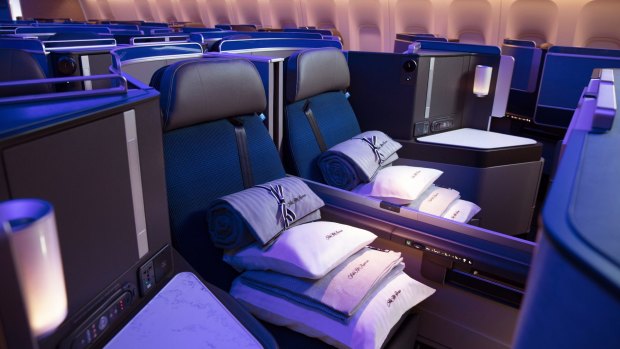
Business class is the new first class: United Airlines' Polaris business class.
At about twice the price of an economy seat, a premium economy seat with maybe 20 centimetres of extra legroom is hard to justify, but how about an economy seat that offers an extra 50 per cent more legroom for an extra 50 per cent loading on the economy fare? Instead of 76 centimetres, how about 114 centimetres of seat pitch, put it into a shell type design so I can recline without annoying the passenger behind and give it a generous recline angle. I'd definitely pay a premium for that, and the airline gets the same revenue a square centimetre.
FLIP-UP ECONOMY SEATS
How much easier would it be to reach a window seat if the seat bottoms of those in between the aisle and the window flipped up? Passengers in the same row could stand and let the window-seat passenger past. As it is, they often have to exit the row to let them past, stopping aisle traffic.
SPLIT LEVEL ARMRESTS
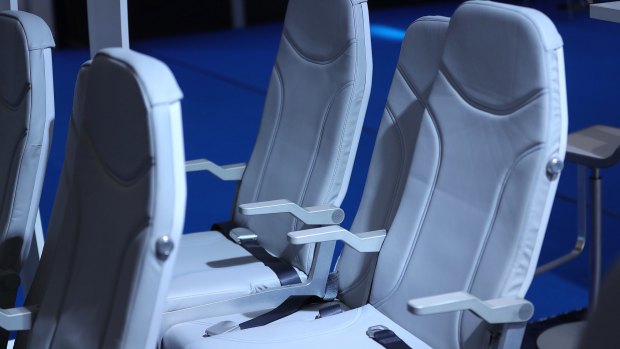
Credit: Bloomberg
The armrest beside each central seat is divided along its length, with an upper and lower half. Every traveller gets a place to rest their arms, avoiding the clash of elbows and the fraying of tempers.
FACIAL RECOGNITION AT AIRPORTS
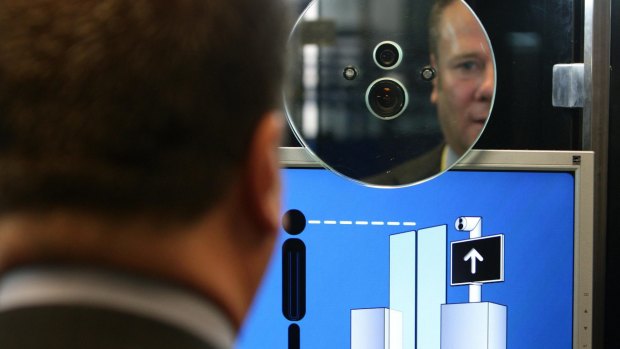
Credit: Alamy
Biometric recognition has the potential to check you in for your flight, give you your boarding pass, pass you through immigration and aboard the aircraft with minimal monitoring from staff, as well as expediting progress through security checkpoints for those who select pre-screening and are deemed to be low risk.
INTERNET WITH MORE ROBUST BANDWIDTH
Plenty of airlines have inflight Wi-Fi but for those that offer it as a complimentary service, download speeds are often woeful. Charging for the service puts a cap on the number of users and the download speed is usually healthier.
A SMART SEAT
Walk down the aisle and your seat glows when you're nearby. Very handy when you're bumbling back from the bathroom in a darkened cabin in the middle of the night.
WINDOWS WITH AN AUGMENTED REALITY OPTION
As an option to looking at clouds or bits of ground from 10 kilometres up, the window has a simulated 3D display of the ground below. In this mode the window is touch sensitive so you can zoom in on cities or natural wonders, with a freeze-frame option. For those not sitting in the window seat, the same display is available over the inflight entertainment system.
A SENSORY DEPRIVATION FORCE FIELD
Select this and you're enveloped in your own personal cone of silence. This could also be customised by the passenger to select from a menu of whalesong, breaking waves and other sleep-inducing sounds.
WHAT'S HERE AND WHAT'S IN STORE FOR THE FUTURE TODAY
EVER CHANGING FLIGHT PRICES
Online ticketing allows airlines' revenue managers, the folks who set the price, to vary the prices from day to day, and even hourly. The question of the best time to book flight tickets inspires endless web debate but the best time to buy is when you see a price you can live with.
TEDIOUS SECURITY SCREENING
The ritual unloading at the security checkpoint is a continuing source of annoyance. Why doesn't Australia do as the US has done with TSA pre-checks? Done thoroughly, pre-screening expedites passenger movement with minimal security risk.
SAFETY IN THE AIR
Last year was the safest on record for passenger air travel, following hard on the heels of the previous record holder – 2016. Measured against the number of passengers carried, the trend line for fatalities caused by aircraft accidents fatalities continues to fall.
EASIER ONE-STOP CONNECTIONS
Traditional airline hubs such as London and Frankfurt are suffering from increasing congestion, but some airlines are thinking well outside traditional routes. Emirates operates a one-stop service from Australia to Venice, Bologna and Casablanca, Qatar Airways now offers one-stop flights between Australia and Nice, Zagreb and Oslo, while the Chinese carriers now operating in Australia have opened up a raft of possibilities for one-stop flights from Australia to European and Asian cities.
NON-STOP AUSTRALIA TO THE UK
A new era in aviation history began this year with the first scheduled non-stop service between Australia and London. Flight time for the new QF9 flight from Perth to London is scheduled at 17 hours 20 minutes, an hour less than the current record holder for the world's longest flight, 18 hours 20 minutes, operated by Qatar Airways between Auckland and Doha.
See: Economy class passengers give their verdict on non-stop Perth to London flight
GREATER AIR PRESSURE
Aircraft with carbon fibre reinforced polymer fuselages such as Boeing's 787 and the Airbus A350 can tolerate higher cabin pressure than traditional aluminium hulls. Higher pressure means more air in your lungs, more humidity and a more comfortable inflight environment.
DISAPPEARING ENTERTAINMENT SCREENS
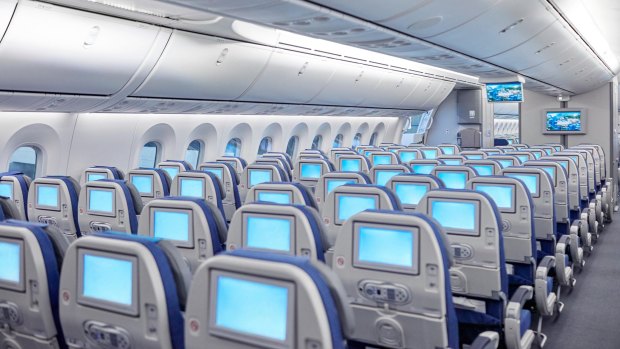
Credit: Alamy
Quite a few budget airlines have already done away with seat-back inflight entertainment screens. It saves weight, saves the airline money and, in some cases, offers them a potential income stream. Instead airlines are streaming inflight video to an app which passengers can download to their own personal tablet or hire one onboard. Qantas is one of the latest to ditch seat-back screens on some domestic flights, joining Virgin, while Jetstar charges for the privilege of watching something other than the back of the seat in front of you.
BASIC ECONOMY FARES
This is a sub-class of economy, the latest attempt by the major carriers to match the rock-bottom flight prices offered by the low-cost airlines. Fly basic economy and conditions are throttled back to the bare minimum. Passengers accrue no points, there's no checked luggage, no access to the overhead locker for a carry-on bag, no flight changes or refunds, seat assignment at check-in and last-on boarding. So far only the major US carriers are offering basic economy fares but expect them to come our way.
LED CABIN LIGHTING
Softer and gentler on the eyes, LED lighting can be tuned to different colours in the spectrum. Some airlines alter the colours to mimic the time of day at the destination – from cool and bright at midday to softly glowing colours at dawn and dusk. LED lighting is also lighter and uses about half the power of fluorescent lighting.
QUIETER AIRCRAFT
It's a subtle and progressive change but aircraft cabins are getting quieter. Engines are more efficient and emit less noise and composite materials provide greater insulation than traditional all-metal aircraft.
CHEAPEST EVER PRICES FOR AIR TRAVEL
Given the ever-increasing number of air travellers, strong competition on major routes and the continuing strength of the Australian dollar, without a surge in fuel prices it's hard to see any dramatic change in the price of air travel in the immediate future.
BUSINESS CLASS GETTING EVEN BETTER
Fly business class with a premium airline and you can expect a cushy lounge with great food, nice wines and expedited immigration clearance, but best of all is the seat. On a long-haul business class flight aboard a legacy carrier your seat converts to a lie-flat bed. Latest refinement is the side-by-side seat in the middle row which converts to a double bed for two. No wonder first class is disappearing.
See also: First class is dying out, even though it's better than ever
MORE CARRIERS
The European carriers including KLM, Olympic, Lufthansa and Alitalia that once picked up and dropped off passengers at Australia's airports are no longer seen in our skies. In their place we have Middle East carriers Emirates, Etihad and Qatar, rated among the world's best airlines, but even more surprising is the number of China-based airlines flying to at least one Australian city. Today there are half a dozen Chinese airlines servicing Australia, ushering in a new era in travel with more airline hubs and routes, and competition that keeps prices low.
AND TOMORROW …
NON-RECLINING SEATS
Since they're lighter, cost less, require less maintenance and give airlines an extra row or two of paying bottoms, non-reclining seats are popular with budget airlines. Now legacy carriers are getting in on the act. British Airways will fit non-reclining seats to its fleet of 35 new Airbus aircraft scheduled to enter service later this year. Expect non-reclining seats to become more prevalent on short-haul routes.
See also: British Airways and other carriers bringin in non-reclining seats
NON-STOP FLIGHTS TO EUROPE FROM EAST COAST AUSTRALIA
This is the holy grail for Qantas, and chief executive officer Alan Joyce is pushing both Airbus and Boeing to increase the range of their twin-engine aircraft to enable the airline to operate the route with a decent payload. That's not too much of a stretch. Airbus created its Airbus 350-900ULR specifically at the urging of Singapore Airlines when it needed a long-legged aircraft for its new Singapore-New York flight.
See also: Qantas looks at the Airbus A350 for non-stop Europe, New York flights
MORE ANCILLARY CHARGES
Airlines have learned that stripping everything but the right to occupy a seat from your ticket price and then charging to re-install such privileges as checked baggage, food and drinks and seat selection is the flight path to success in the industry. This is the template for budget carriers, and legacy carriers are getting leaner and meaner as they compete for market share.
BEYOND
Supersonic flights
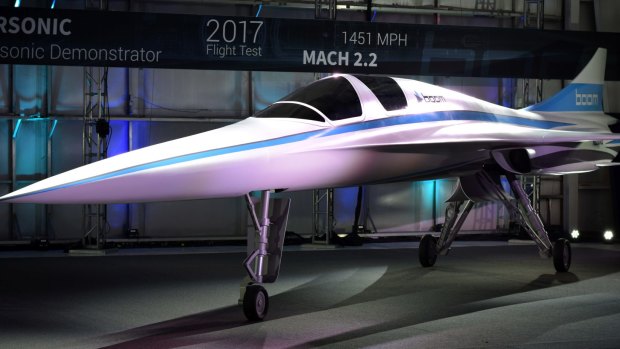
Still on the drawing boards of major aircraft manufacturers, and realistically it's at least a decade away before the first passenger sets foot on a commercial supersonic flight, but supersonic passenger flight didn't die with the last Concorde take-off. Leading the charge is Boom Technology, a US start-up planning to test fly its XB-1 Supersonic Demonstrator "Baby Boom", a 1/3 scale version of the Boom passenger aircraft, in 2018. The prospect of seven-hour flights from east coast Australia to Los Angeles, 10 to London, is one to savour.
See also: The Boeing supersonic jet that never took off for Qantas
More carbon emissions from jet aircraft
Aircraft engines are becoming more fuel efficient but nothing like the pace at which the number of air travellers is increasing – more than 7 per cent in 2017. A day of reckoning is on the horizon, with taxes on aviation fuel to dampen down demand and an emissions trading scheme as possibilities.
See also: World's best airline for 2018 named
Sign up for the Traveller newsletter
The latest travel news, tips and inspiration delivered to your inbox. Sign up now.